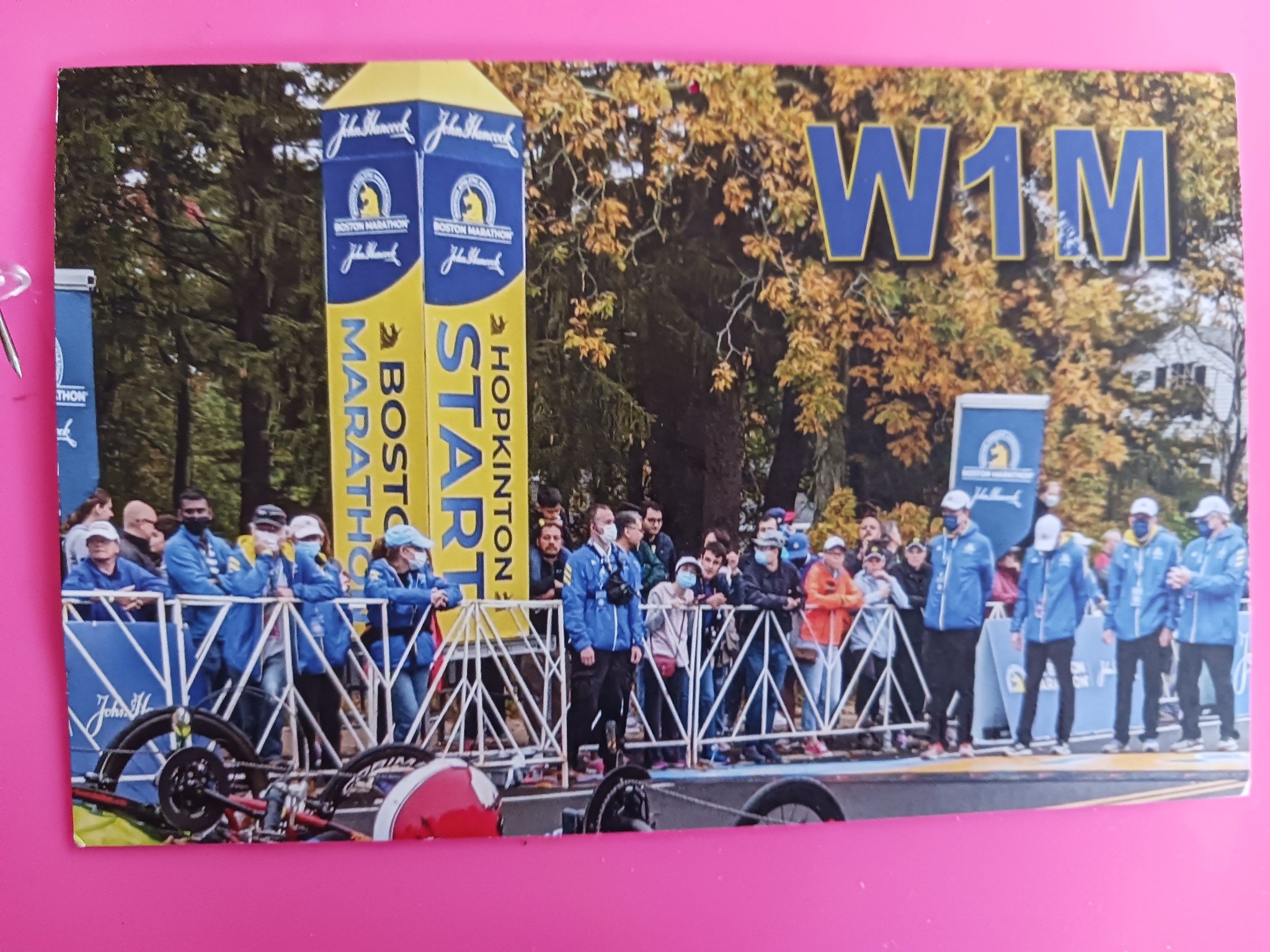My first year as a technician I volunteered to be on the amateur radio team at the 2022 Boston Marathon. It was a very good experience for me as a beginner and lots of folks in my club helped me train and prepare to do my work..
The operator of the starting line sent me a QSL card. I am happy to add it to my small collection.They also gave us a official jacket and a pin.
As a technician there are lots and lots of fun things you can do with your new license. My good friend Bill suggested APRS as a great place to start my newfound FCC grant adventure. APRS is automatic packet reporting system and it can be done relatively inexpensively with great rewards. I used a set up very much like the photograph here and was able to easily connect to a digipeater in my area to put my beacon up. Google has aprs.fi to track other hams. I used an old cell phone and a program called APRS droid. Loads of fun and some clubs use weather balloons with an aprs beacon inside that you can track using the aprs.fi. It allows you to change your beacon into whatever you choose You can also send messages via the airwaves. with aprs like a text message. It is definitely something I reccomend for anyone new to the hobby..
144.39 is the 2-meter frequency for North America.
Friday, March 31, 2023
I always hear folks saying on the repeater they did not do any radio today. My first thought is what you just did was radio. It seems a bit funny but talking on a repeater or 2 meter simplex is actually a privilege that we earned by passing our amateur radio exams. I myself have spent loads of time talking with my friends on the repeater, it is a great way to have fun with your license. A lot of clubs hold nets and if you listen and talk long enough on the repeater you may find out what time these things are happening. So remember if you are telling someone you did not do any radio today on the 2 meter radio you just actually accomplished your goal of doing some radio.
I will add a couple links here about programing your radio to link into a repeater.
https://www.repeaterbook.com/index.php/en-us/
Repeaterbook is very comprehensive and a great way to find your local repeater.
https://chirp.danplanet.com/projects/chirp/wiki/Home
Chirp is a free software program that can help you link to repeaterbook and program your radio. The only thing about chirp I will say is to verify it supports your rig prior to running it. On the first page there is a list of supported radios.
https://en.wikipedia.org/wiki/2-meter_band
If you want to read more about FM operation on 2 meters here is a very comprehensive guide.
Of course when we are talking about being a Technician we cannot forget about Morse code. As a technician you have operating privileges on 40 15 and 10 meter band so if you wanna try something fun. Join a CW club and start practicing to enjoy your license to the fullest extent.
AS A TECHNICIAN I RECOMMEND YOU SPEND SOME TIME MEMORIZING THIS NATO PHONETIC ALPHABET.
THIS IS the phonetic alphabet. THIS IS how AMATEUR RADIO OPERATORS. make contacts by exchanging callsIGNS with the nato phonetic alphabit
As a technician you could contact the international space station. The astronauts use 2 meter and 70 centimeter frequencies that are well within your privileges.
Heavens-Above is a great app for tracking satellites and the ISS. this is a great tool and an opportunity to build a Yagi antenna and try to make an ISS or a satellite contact. There are thousands of amateur radio satellites circling the earth launched by Hams into space for use on mostly technician band. The ISS also sends SSTV images down to earth you could potentially receive an image from space. Click on the link below to read more about this.
5/1/2023 Ham Radio operators speak to each other with code words. We are not trying to obscure the meaning of what we say we are just abbreviating things in a way that all of us understand. I suggest memorizing the most common Q codes so that if someone uses one you will understand what they are saying. If someone ever uses a Q code and you do not understand, do not ever be afraid to ask. Most hams are happy to oblige with an explanation.
2/3/2024
This is a fun activity also. and as a technician you can listen anywhere.
Pirate radio frequencies include123:
3900-3950 kHz (75 meter amateur band)
4000-4200 kHz
5100-5200 kHz
6200-6450 kHz
6700-7000 kHz
7400-8100 kHz
6765-7000 kHz (43 meters)
6100-6400 kHz (49/46 meters)
5/23/2024
If you are a Ham operator in the Manchester NH or surrounding area and would like to be a guest NET controller follow the link below
73
Tim
KC1QDK
6/4/2024
Making Coax Connectors is a great skill to have I found a really good YouTube video on it.
JOIN ARES Amateur Radio Emergency Service lots of great activities to get involved with including public events and emergency preparedness. Most of the ARES activities you only require a Technician license and they are very happy to have your help.











